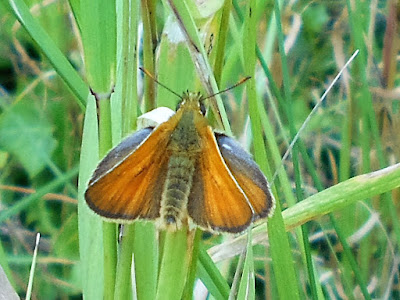Not far from our house at Stefen Hill is a very busy junction where the A45 meets the A361. The junction has been so constructed that an area of perhaps seven or eight thousand square yards has been left as a virtual island, shown in green on the map.
 |
| A refuge beside the A45. |
This little patch is difficult to reach and I therefore suspect that no one has set foot there since the structure was completed some twenty or so years ago. The consequence is that nature has run riot, not with rarities of course, but with a colourful range of plants to be expected on roadside verges.
 |
Nothing rare, but bliss for insects. The A45/A361 junction.
21 July, 2016
|
The brambles, wild roses, and sprawling hawthorn shrubs make the area difficult to penetrate but as a child I was fed on Virol, so these obstacles are nothing to me! The brilliant yellow flowers of the much maligned Common Ragwort, Senecio jacobaea, were proving a magnet for insects, while caterpillars of the Cinnabar moth, Tyria jacboaeae, were present in their hundreds, munching away at the toxic leaves.
 |
Cinnabar caterpillars. Roadside, Daventry,
21 July, 2016
|
Another, less obvious caterpillar was present, snug in an umbel of Hogweed, Heracleum sphondylium. This was the larva of the Parsnip Moth, Depressaria radiella, enmeshed in a silken purse (in the U.S.A. it is known as the Parsnip Webworm).
 |
Parsnip Moth caterpillar. Roadside, Daventry.
21 July, 2016
|
I coaxed it on to my net for a better picture but, cruel though my judgement may be, I would not class it as stunningly beautiful.
Butterflies and moths abounded: Marbled Whites (Melangaria galathea), a camera-shy Gatekeeper (Pyronia tithonus) that hid behind a thicket of bramble, and dozens of flitting skippers. The Gatekeeper is a species that has declined over the last couple of decades due - probably - to habitat loss and I was therefore pleased to see it.
 |
Gatekeeper beside the A361, Daventry.
21 July, 2016
|
As for the skippers, once a specimen stayed still for more than a second I was able to note the black underside of the antenna tips, showing it to be an Essex Skipper, Thymelicus lineola.
 |
The Essex Skipper, by no means confined to Essex. Roadside near
Daventry. 21 July, 2016
|
Grasshoppers were abundant too - always, I feel, an indication of a healthy habitat. So, despite heavy lorries thundering past, this patch is a real haven and, as it is likely to remain untouched, should remain so for the foreseeable future. Yes, I did take a few specimens home for identification, but far fewer than a bird such as a House Martin would consume daily. I didn't feel guilty.
e-mail Tony at: diaea@yahoo.co.uk
e-mail Tony at: diaea@yahoo.co.uk

No comments:
Post a Comment